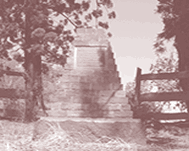Demolished Heritage Buildings
Blacktown Railway Station was a magnificent sandstone structure unfortunately demolished. The sandstone blocks were used in another area of Sydney. The railway line to Blacktown was opened 4th July 1860 and once had a private railway connecting the line to Prospect Quarry. (The quarry had opened in the 1880's.) The railway line crossed the Great Western Highway at its junction with Toongabbie Road and operated from 7th April 1902 until 1945 . Prior to 1902 a narrow gauge tramway was used. There was also another private railway which ran from Prospect Quarry to Fairfield and operated from 26th October 1925 to 2nd June 1945.
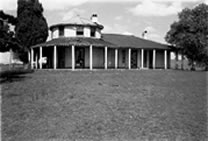
Bungarribee House, Doonside was built in 1827 for Colonel John Campbell, NSW Governor's Secretary. It was located on Doonside Road. Purchased by Thomas Icely in 1828, it was unfortunately demolished in 1957, by the Overseas Telecommunications Commission. Images by Barry Wollaston provided with kind permission of The Historic Houses Trust of NSW.
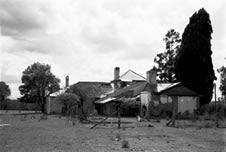
Rear view of Bungarribee House

Bungarribee House's rotunda verandah.
Fox-under-the-Hill was located where Fox Hills Golf Club is now located and marked the commencement of the Prospect village. Described in 1909 by William Frame as:
"Fox-under-the-Hill, a picturesque old farm-house, but formerly, in the good old coaching days, a public house, kept 77 years ago by one Peisley. From here the village commences- an hotel called the Prospect Inn, and old enough to have some historic interest: a public school, a store, a smithy, an old-fashioned roomy cottage (belonging at one time to the Goodwins, a pioneer family of many years ago) and a little Roman Catholic church are the chief features of the central part of the settlement. But near at hand is Veteran Hall, formerly the seat of Lieut. Lawson R.N., and one of the explorers of the Blue Mountains."
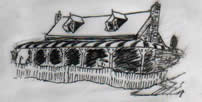
Gipps Road Cottage, Greystanes. The home of John Booth, a farmer and alderman of Prospect and Sherwood Council. This cottage was down the road from Grey Stanes. It stood on the present day Gipps Road, Greystanes.
Image drawn by Ian McGowan
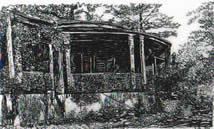
Grey Staneswas built in the late 1830's by William Lawson. It was the home of Nelson Simmons Lawson, William Lawson's son. Described in 1909 by William Frame as
"splendid old stone mansion is now occupied by the engineer-in-chief of the M.B. and W.S. and S. local establishment, which includes the reservoir, the pumping station and several rather nice cottages. The Crown of Prospect Hill - that beautiful hill that is such a landmark for many miles around - is occupied by "Greystanes" formerly occupied by Nelson, Lawson...associated with the names of Walter Lamb, F.W. Wentworth and A.F. Smart. This fine old estate is owned by Captain P. Charley, of Belmont Park, and is undoubtedly one of the finest properties in Central Cumberland, the view from the gardens being magnificent. Upon the rise of another hill is St Bartholomew's Church of England, an interesting old church, founded largely through the efforts and generosity of the Lawson's, of Veteran Hall and Greystanes, the Westons of Horsley and the Crawfords of Hill End (Doonside)." Jill Finch, Secretary Prospect Heritage Trust has information that shows that the engineer-in-chief in fact lived in Veterans Hall.
Image drawn by Sarah Fior.
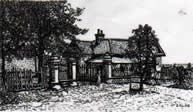
Grey Stanes Lodge The original entrance to Greystanes property. The gates still stand on Greystanes Road, Greystanes.
Image drawn by Sarah Fior.
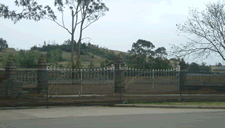
Greystanes Gates These are Grey Stanes gates on Greystanes Road, Greystanes.The gates were widened to allow trucks to enter the BMG/Boral quarry. The land around these gates has now been developed into a housing estate.
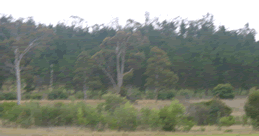
The surrounding hills were once heavily forested as the image on the right shows. I have read old newspaper articles that stated that the area was to be returned to its original state when Blue Metal Gravel (BMG) closed. Perplexingly this has not happened and the ridge on the other side is now heavily industrialized at a loss to Blacktown residents. The industrialized area is the responsibility of Holroyd Council.
The Robin Hood Hotel located directly opposite Blacktown Railway Station, it was demolished on a Sunday and without prior notice. In fact many patrons arrived the following Monday to find the building flattened by bulldozer. The Robin Hood bottle shop had been selling wine the previous Saturday night at a huge discount. Next door to the Robin Hood stood the Maid Marion milk bar, once one of few in Blacktown, the other being the West End milk bar and The Star.
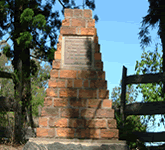
William Lawson's Cairn, Prospect, marking the site of his home Veteran Hall. The cairn also commemorates Lawson as an explorer. Lawson, Wentworth and Blaxland first found a path for oxen to cross the Blue Mountains, opening the way to the west. All three have towns in the Blue Mountains named after them. The site is well above the water line of Prospect Reservoir and it did not need to be demolished for Prospect Reservoir. The cairn was built in 1969 by two Water Board engineers.
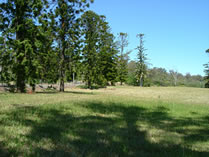
Site of Veteran Hall looking south. The site lies beneath Prospect Hill.

Looking towards Prospect Reservoir from Veteran Hall site. In Lawson's time the view would have been of Lawson's farm which now lies dormant under the water. There is a fence around this and it is difficlut to notice from the road nut if you look you will find it.
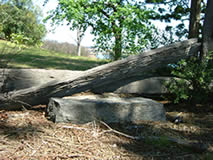 All that is left of Veteran Hall. The lone stone. The image also shows a paling from a split log fence All that is left of Veteran Hall. The lone stone. The image also shows a paling from a split log fence

Prospect Hill
Despite its heritage Prospect Hill is now ruined by an Open Cut Mine. This land (the Lawson's Greystanes Estate) was originally meant to be returned to its natural state. This had not happened and instead Boral have developed it for industrial use - despite its heritage value.
|
